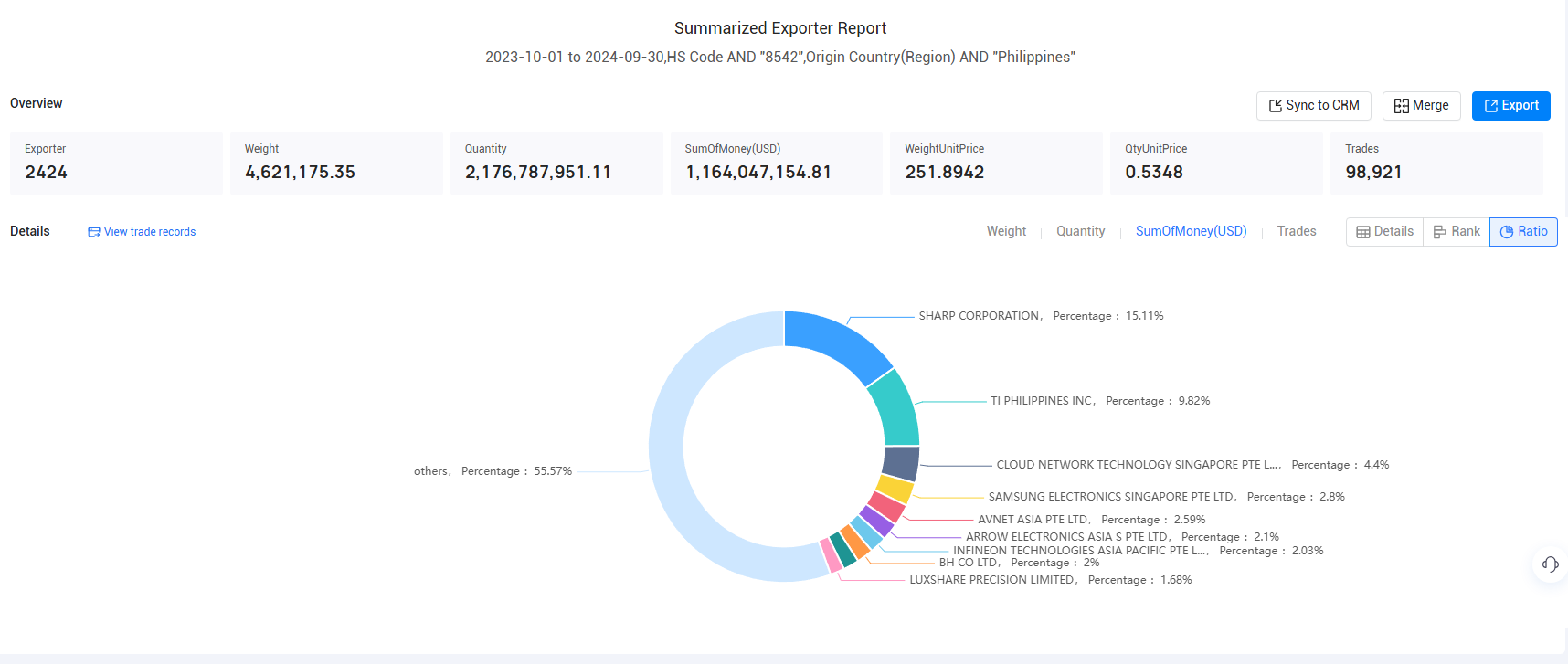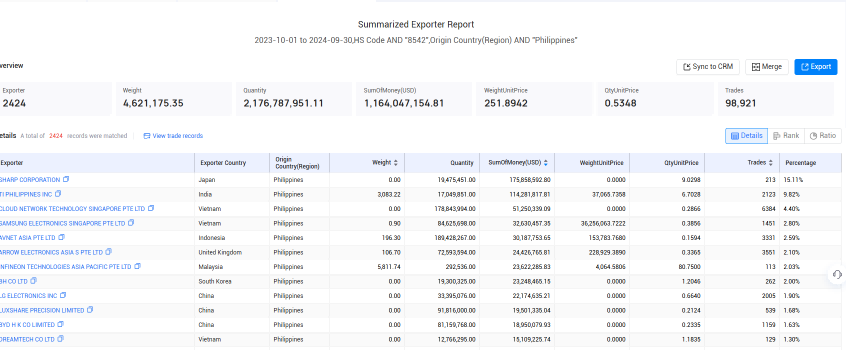 Trade Data Provider
Trade Data Provider
 11-11-2024
11-11-2024
The Philippines, an archipelago in Southeast Asia, has long been recognized for its dynamic and growing economy. With a population of over 100 million, a diverse industrial base, and strategic location in the Asia-Pacific, the Philippines has become a key player in global trade. Understanding the Philippines' export data provides invaluable insights into the health of its economy, the performance of its industries, and its competitive position on the world stage.

Why Philippines' Export Data Matters
As of recent years, the Philippines' export data reflects the continued importance of key sectors such as electronics, machinery, agricultural products, and business services. Electronics remain the largest export category, with semiconductor devices and circuit boards leading the charge. In fact, the Philippines is one of the world’s largest suppliers of semiconductors, which are crucial components in various industries like technology, automotive, and consumer electronics.
Other significant Filipino export data highlights include mineral products, chemicals, and agricultural goods such as coconuts and tropical fruits. These sectors are complemented by the growing exports of services, particularly in the fields of IT, digital solutions, and healthcare.
1. Philippines' export data offers more than just statistics: it is a critical tool for understanding the country’s economic health and global positioning. By closely monitoring export figures, businesses, government agencies, and investors can gain key insights into the performance of various industries and identify emerging trends.
2. Trade Partnerships and Policy Decisions: Filipino export data can shed light on the country's major trading partners, helping policymakers assess which international relationships are most vital.
3. Business Strategy and Market Expansion: For businesses, understanding the trends and shifts in Philippines' export data is essential for making strategic decisions.
>>CLICK HERE FOR EXPORT DATA<<
Philippines' Top Exports in 2023:
· HS Code 8542 (35%, $25 billion): Electronic integrated circuits and microassemblies
· HS Code 8544 (4.18%, $3.05 billion): Insulated (including enamelled or anodised) wire, cable (including co-axial cable) and other insulated electric conductors, whether or not fitted with connectors; optical fibre cables, made up of individually sheathed fibres, whether or not assembled with electric conductors or fitted with connectors
· HS Code 7403 (2.68%, $1.96 billion): Refined copper and copper alloys, unwrought.
· HS Code 8504 (2.41%, $1.76 billion): Electrical transformers, static converters (for example, rectifiers) and inductors
· HS Code 8443 (2.15%, $1.57 billion): Printing machinery; used for printing by means of plates, cylinders and other printing components of heading 84.42; other printers, copying machines and facsimile machines, whether or not combined; parts and accessories thereof
· HS Code 8541 (1.8%, $1.31 billion): Semiconductor devices (e.g. diodes, transistors, semiconductor based transducers); including photovoltaic cells assembled or not in modules or panels, light-emitting diodes (LED) assembled with other LEDs or not, mounted piezo-electric crystals
· HS Code 8471 (1.76%, $1.28 billion): Automatic data processing machines and units thereof; magnetic or optical readers, machines for transcribing data onto data media in coded form and machines for processing such data, not elsewhere specified or included
· HS Code 0803 (1.67%, $1.22 billion): Bananas, including plantains, fresh or dried
· HS Code 7108 (1.65%, $1.2 billion): Gold (including gold plated with platinum) unwrought or in semi-manufactured forms, or in powder form
· HS Code 1513 (1.61%, $1.17 billion): Coconut (copra), palm kernel or babassu oil and fractions thereof, whether or not refined, but not chemically modified

>>CONTACT TENDATA FOR TRADE DATA<<
Navigating Philippines' exports with Tendata
Given the importance of export data in shaping business strategies and government policies, Tendata offers a wide range of tools designed to provide real-time and historical data on the Philippines' exports. With Tendata, users can access detailed Filipino export data, including information on trade volumes, product categories, and major markets. The platform offers a user-friendly interface, allowing businesses, analysts, and policymakers to easily track and interpret export trends.
Key features of Tendata include:
· Comprehensive Data Coverage: Tendata covers a wide array of export categories, from electronics and machinery to agriculture and services, giving users a well-rounded view of the Philippine export landscape.
· Customizable Reports: The platform allows users to create tailored reports based on specific industries, regions, or timeframes. This customization is crucial for companies and analysts who need to focus on particular market segments.
· Real-Time Updates: With real-time data updates, Tendata ensures that users have access to the most current information, enabling quick decision-making in fast-paced markets.

The Filipino export data is a vital resource for understanding the nation’s economic performance, trade relationships, and growth opportunities. By analyzing these data points, businesses can refine their strategies, investors can identify promising sectors, and policymakers can craft informed decisions that drive the country’s economic development.
Tendata are revolutionizing the way businesses and organizations access and leverage Filipino export data, providing them with the tools needed to stay ahead in a competitive global market. With accurate, up-to-date insights into the Filipino export data, users can make smarter decisions and identify new opportunities.
>>CONTACT TENDATA FOR A FREE DEMO<<
Category
Leave Message for Demo Request or Questions


 T-info
T-info T-discovery
T-discovery

 My
Tendata
My
Tendata Market Analysis
Market Analysis Customer
Development
Customer
Development Competitor
Monitoring
Competitor
Monitoring Customer Relationship
Customer Relationship






































































































































